Discover the Art of Making Ghewar: A Traditional Delight
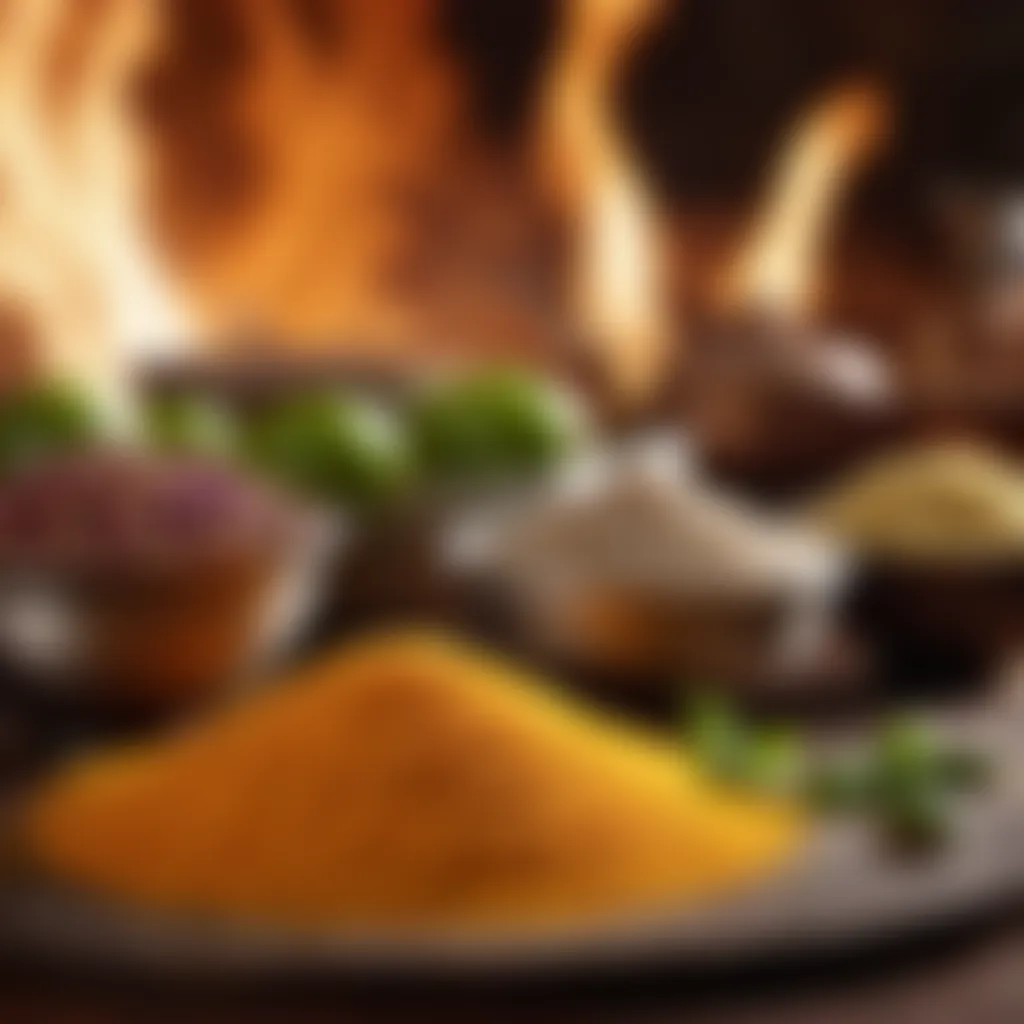
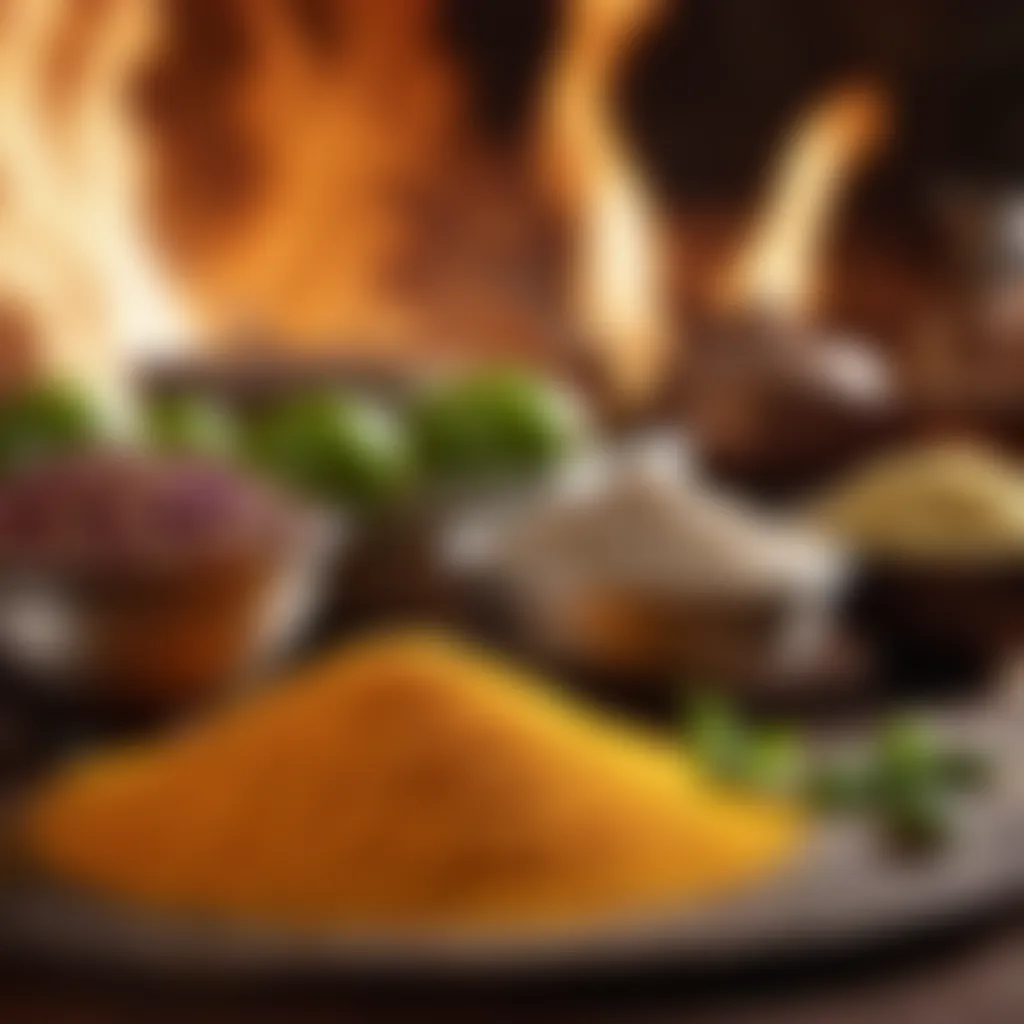
Intro
Ghewar is not just any dessert; it is a floral delight sprinkled with the essence of tradition and history. Primarily popular in Rajasthan, this dessert is often made during festivals and special occasions, particularly during teej and raksha bandhan. It is characterized by its exquisite honeycomb texture and subtly sweet flavor, making it a sought-after dish for both celebrations and personal indulgence. As we dive into this culinary gem’s intricacies, we will explore how to master the art of making Ghewar in your own kitchen, ensuring you provide a delightful take on this beloved confection.
Ingredients:
To create Ghewar, having the right ingredients is key. Here’s what you need to bring this dessert to life:
- All-purpose flour (maida): 2 cups
- Semolina (sooji): 1/4 cup
- Ghee (clarified butter): for frying and 1/2 cup for batter
- Baking soda: 1/2 tsp
- Cold water: Approximately 1.5 cups
- Milk: 1/2 cup
- Sugar: 3/4 cup
- Cardamom powder: 1 tsp
- Saffron strands: A pinch, soaked in 1 tbsp warm milk
- Chopped nuts (almonds, pistachios): for garnishing
- Rose water: 1 tsp
Preparation Steps:
Making Ghewar involves a few precise steps that ensure you capture its delicate essence:
- Prepare the Batter:
In a large mixing bowl, combine the all-purpose flour and semolina. Gradually add ghee and mix until crumbly. Slowly pour in cold water to create a smooth batter, then whisk in the milk until you achieve a thin consistency. - Add Flavoring Agents:
Stir in sugar, cardamom powder, saffron-infused milk, and rose water. Allow this mixture to rest for around 30 minutes, which helps enhance the flavors. - Heat the Ghee:
Heat enough ghee in a thick-bottomed pan or Kadai at medium heat. To check if the ghee is ready, drop a little batter into the ghee; it should sizzle and come to the surface.
Technical Aspects:
Getting the texture right is crucial in Ghewar-making:
- Temperature: Keep the oil at medium heat to ensure even cooking. If too hot, the Ghewar will burn; too cold, it will absorb too much oil.
- Timing: Each layer of Ghewar should be cooked for about 3-5 minutes until golden brown.
Cooking Process:
Ghewar’s unique shape and texture are why it stands out:
- Create the Honeycomb:
Once the ghee is hot, take a ladle and pour the batter in the center of the ghee. Start pouring from a height, swirling around to form a circular shape, allowing the batter to flow back into the center. - Layering:
Repeat the process, adding more batter in a circular motion to build layers. Each layer will cook while the previous one sets, resulting in the desired honeycomb structure. - Draining:
After achieving a beautiful golden brown color, remove the Ghewar and set it on paper towels to drain excess oil.
Troubleshooting Tips:
If your first attempt doesn’t go as planned, don’t fret. Here are a few common issues and solutions:
- Ghewar Too Dense:
If the texture is off, it might be that the batter was too thick; try adding more water during the mixing phase. - Oil Absorption:
Ensure the ghee is heated adequately before starting; if the temperature is low, the Ghewar will soak up oil.
Remember, patience is the key. The beauty of Ghewar lies in its texture, and sometimes it takes a few tries to get it just right.
Closure
Making Ghewar is a labor of love, rooted deeply in regional culture and tradition. By following the steps outlined above, you not only embrace the recipes passed down through generations but also create a unique experience to share with your family and friends. So step into your kitchen, gather the ingredients, and let the magic unfold as you craft this stunning traditional delicacy.
Foreword to Ghewar
Ghewar is not just another dessert; it's a tapestry woven with rich cultural threads, a labor of love, and an emblem of celebration in many Indian households. This traditional sweet treats the taste buds to a journey that delves deep into regional flavors and practices. Understanding Ghewar means appreciating its unique historical significance and the artisans behind its creation. From weddings to festivals, its presence is a testament to the nurturing spirit of Indian cooking, showcasing how something so simple can carry profound meanings.
Historical Context
The origins of Ghewar trace back to the arid landscapes of Rajasthan, where climatic challenges forced communities to innovate. It is said that this sweet was first made to celebrate festivals, particularly during Teej, which honors the monsoon rains. The tradition of making Ghewar has been passed down generations, from grandmothers teaching their daughters to local vendors perfecting their craft. The preparation process echoes through time, where the art of frying the delicate batter hangs between skill and patience. It’s not uncommon for families to gather around during festive seasons, sharing stories and laughter as they whip up this exquisite dish.
Ghewar's historical relevance isn’t just in its recipe. It symbolizes the communal spirit and ingenuity of its creators, who used available resources to make something extraordinary. As the years rolled on, the humble Ghewar transformed into a symbol of festivity and togetherness, with its rugged edges resembling the landscape of Rajasthan in its rawest form.
Cultural Significance
To understand Ghewar is to understand the diverse cultural fabric of India. It’s more than a sweet; it holds memories, traditions, and family ties. During festivals like Raksha Bandhan and Teej, Ghewar is exchanged as a gesture of love and affection. It embodies the spirit of celebration, marking moments of joy with its intricate layers and sweet syrup.
"Ghewar represents not just a dish but a celebration of life itself – a moment shared between people that transcends time."
In addition to being a delectable treat, Ghewar plays a crucial role in various rituals and gatherings. For instance, in certain parts of Rajasthan, it is an integral part of pre-wedding festivities, often prepared in elaborate quantities to serve large gatherings. Each bite is steeped in purpose and nostalgia, transporting the one consuming it back to a simpler time, surrounded by laughter and love.
As people rediscover such culinary traditions, Ghewar stands as a reminder that sometimes, in our rush to modernity, we must not forget the roots that nourish us. Thus, the importance of Ghewar extends beyond its taste; it's an invitation to explore a world rich in stories, traditions, and flavors that hold the essence of Indian culture.
Essential Ingredients
In the world of Ghewar, the essence lies in its ingredients. Each element plays a crucial role, turning simple components into a masterpiece celebrated by many. A proper understanding of these essentials is critical to crafting this intricate dessert. Not just any ingredients will suffice; they need to be of the highest quality to achieve that distinct texture and flavor that Ghewar is famous for.
G Flour
The backbone of Ghewar is undoubtedly G Flour, also called mawa flour. It's a finely milled wheat flour that lends the dessert its characteristic lightness and cloud-like texture.
Using the right flour is vital. Many may wonder, why not just regular flour? Well, G Flour has a unique gluten structure that captures air while frying, creating those divine holes within the Ghewar.
- Quality Matters: Opt for freshly milled flour whenever possible. The freshness directly influences the food’s final taste and texture.
- Handling: One common mistake is to overwork the batter. Treat it with care for the best results.
Sugar Syrup
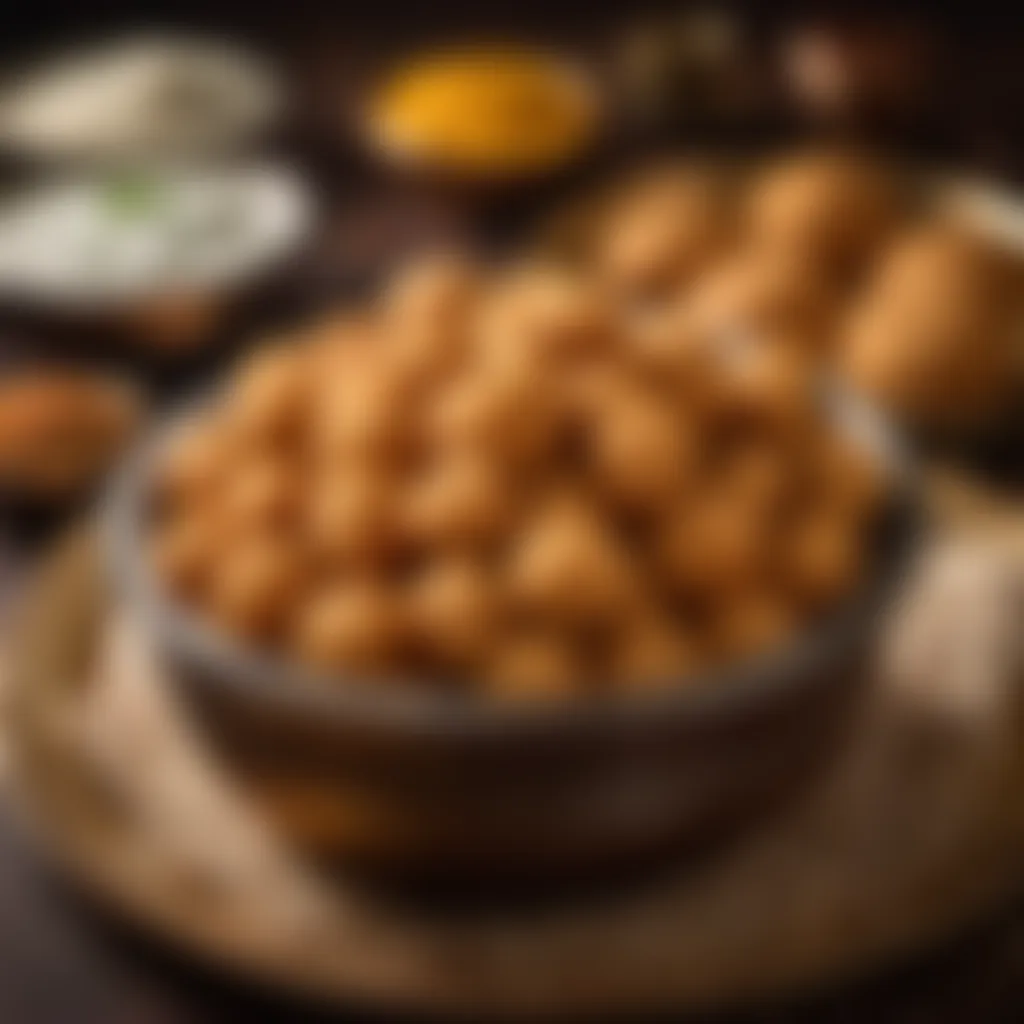
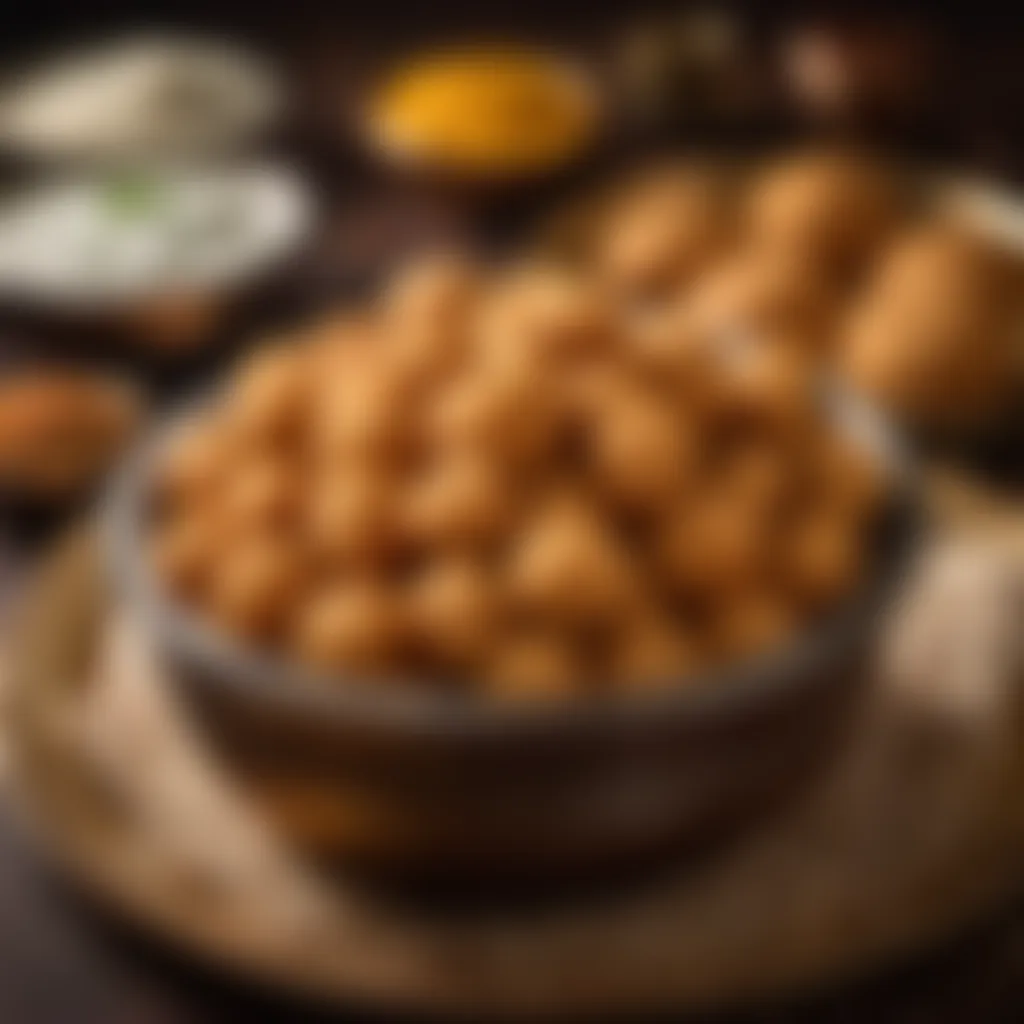
Sugar syrup is the liquid charm that sweetens and binds the layers of Ghewar. It’s not just about sweetness, it’s about achieving the right consistency. The syrup must be neither too thick nor too thin.
Here's the trick:
- Perfect Temperature: Use a candy thermometer to monitor the syrup’s temperature. An ideal point is around 1 string consistency—this means when you drop a bit from a spoon, it forms a thin thread between your fingers.
- Infusing Flavors: While some prefer plain syrup, adding a hint of cardamom or saffron can elevate the taste. Each bite then becomes a flavorful experience, tantalizing to the palate.
Flavorings and Spices
Flavorings and spices are the secret weapons that take Ghewar from a simple dessert to an unforgettable culinary experience. The use of cardamom, saffron, or even a splash of rose water, can transform it into a delicacy that dances on your tongue.
- Cardamom: It brings warmth and an exotic fragrance.
- Saffron: The golden threads not only add a beautiful color but also enhance the richness of the dish.
- Rose Water: Just a dash, and suddenly, your Ghewar becomes a royal dish, evoking memories of age-old traditions.
These ingredients come together, not merely to create Ghewar, but to tell a story—a story rich in culture and tradition. With the right balance and preparation, the magical transformation from raw components to a delightful dessert is nothing short of alchemy.
Whether serving at special occasions or enjoying a quiet afternoon treat, knowing these essentials ensures a delightful Ghewar every time.
Preparation Techniques
Preparing Ghewar requires precision and care, as every step contributes to its unique texture and flavor profile. Ensuring the right techniques are employed not only guarantees a successful outcome but also enhances the overall presentation and enjoyment of this traditional delicacy. Missing a crucial detail at any stage could jeopardize the final product. Therefore, mastery over these techniques is essential for any aspiring cook looking to impress family or friends during festive occasions.
Mixing the Batter
The initial step in creating Ghewar revolves around mixing the batter. Here, quality matters. It's essential to use fine G flour, as this will help in achieving the light, porous nature that characterizes the dessert. Begin by sifting the flour to avoid lumps. Once sifted, combine it with water, Ghee, and a pinch of salt in a large mixing bowl. Mixing it well while gradually adding water is key— you want to create a batter that is neither too thick nor too runny.
Tip: Sometimes, people can overlook the organic nature of ingredients. Using fresh, high-quality ghee can make a world of difference in flavor.
As you mix, the incorporation of air becomes vital. The more air bubbles you trap in the batter, the fluffier the Ghewar will turn out. A light touch can go a long way. A whisk or a mixer can help combine everything more uniformly, but be careful not to overdo it. The goal is a smooth batter that almost falls from your spoon— but isn't watery.
Achieving the Right Consistency
Getting the consistency right is a science and an art. A crucial aspect of the Ghewar preparation is ensuring the batter flows evenly when poured into hot ghee. If the batter is too thick, it won’t spread well, leading to a dense and heavy texture. On the flip side, if it’s too thin, it may not hold its shape, resulting in a flimsy, unappetizing outcome.
Here’s a simple test: take a small amount of the batter and drop it back into the bowl. If it forms a soft mound that slowly sinks back down, you’re good to go. Some home chefs find that adding a bit more water can fine-tune the texture. It’s often a balancing act, so feel free to adjust as needed, while keeping the decadently fluffy final product in mind.
Frying Process
Frying is where the magic happens. Prepare your deep frying pan or kadhai by heating enough ghee, ensuring it reaches an optimal temperature before pouring in the batter. Ideally, the temperature should be around 180°C. A good test: when you drop a small amount of batter into the ghee, it should sizzle and rise immediately. If it sinks, the oil isn’t hot enough.
Once you pour the batter into the hot ghee, a swirling motion will help spread it out. Let it fry for a short while before you start pouring more batter over the existing layer, creating that characteristic layered pattern of Ghewar. This process will continue until you’ve used up all the batter.
After frying, you should remove the Ghewar when it’s a lovely golden brown. Make sure to drain excess ghee by placing it on absorbent paper. This step might seem trivial, but it directly impacts the final taste and texture.
Regional Variations of Ghewar
Ghewar is not just a dessert; it reflects the soul of the regions that create it. Each geographical area in India brings its unique twist to this beloved sweet, showcasing local tastes, traditions, and influences. This section dives into the distinctive styles of Ghewar found across the nation, illuminating how local ingredients and cultural practices shape this culinary delight.
Jaipur Ghewar
Jaipur Ghewar is perhaps the most renowned type, famous for its distinct texture and rich flavor. Known as the queen of Ghewar, it plays a star role during festival seasons, especially Teej. The traditional preparation in Jaipur follows a meticulous process, where the batter is poured into a circular mold, allowing it to take on a lace-like appearance. This design not only adds aesthetic appeal but also enhances the crispiness.
In Jaipur, the Ghewar is often served with a drizzle of sugar syrup and garnished with nuts such as almonds and pistachios. There are two notable varieties:
- Mawa Ghewar: Richer and creamier, this version is made with mawa (milk solids), offering a delightful fusion of flavors.
- Honey Ghewar: Slightly sticky, this variant utilizes honey instead of sugar syrup, providing a distinct sweetness that tantalizes the palate.
The locals often say that the secret to Jaipur Ghewar lies in the air and the water, making it essential to always use locally sourced ingredients. It gives the Ghewar its unique taste that no one can replicate.
Delhi-style Ghewar
Shifting to the bustling streets of Delhi, Ghewar here has adapted to the urban palate. While traditional recipes persist, street vendors and bakeries have developed quick, convenient versions that cater to a fast-paced lifestyle. Delhi-style Ghewar often features a dense, moist texture compared to its lighter cousins.
Here’s what sets it apart:
- Flavoring Variants: Delhi’s grocery stores might stock varieties like rose or saffron flavors, adding an aromatic twist that enriches the dessert.
- Serving Style: Unlike Jaipur’s ambrosial presentation, Delhi Ghewar might come topped with instant cream and colorful garnishes, appealing to the dash and splash of urban life.
You’ll often find this in local festivals and family gatherings, as it encapsulates a blend of tradition and modernity. The saying goes that "Ghewar tastes best when shared with loved ones,” signifying its role in community bonding.
Rajasthani Influences
The heart of India’s dessert culture can be felt in the breadth of Rajasthani influences on Ghewar. Beyond a single recipe, Rajasthan unlocks a treasure trove of adaptations.
In different towns such as Jodhpur or Udaipur, each community showcases its unique twist on Ghewar. Variations may include:
- Kesar Ghewar: Made with saffron, this version captures the essence of royal taste, often enjoyed during wedding feasts.
- Khoya Ghewar: Infused with khoya, this Ghewar is an indulgent option that marries flavors of milk with traditional sweetness.
- Feroze Ghewar: Sturdier in nature, this variation is prepared with an inclination towards rich textures, making it suitable for longer shelf life.
The essence of Rajasthani Ghewar is reflected not just in the flavors but in how it brings together people during celebrations. It’s said that every family has its own special recipe passed down through generations, and sharing these variations creating a bridge across community lines.
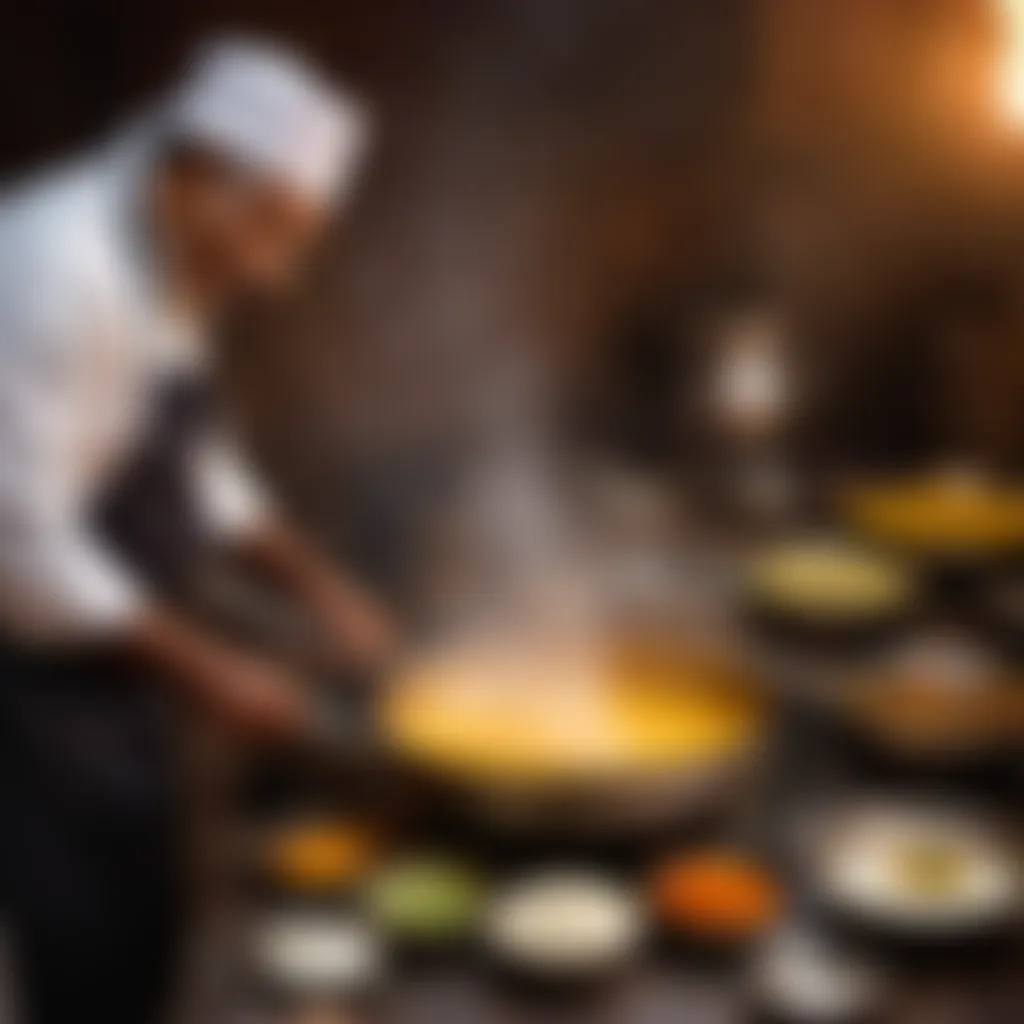
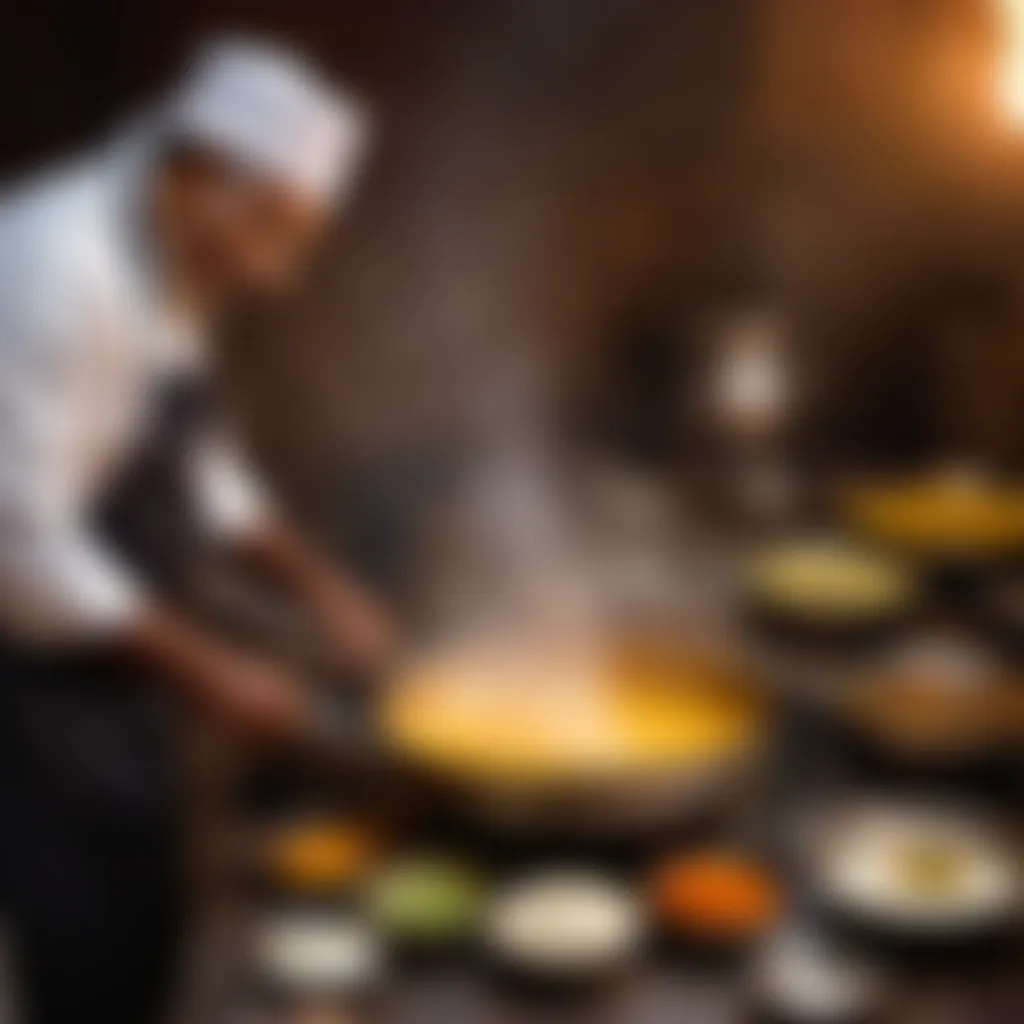
"In every bite of Ghewar, you taste a piece of Rajasthani heritage, an invitation to savor the history."
Overall, understanding these regional variations enriches the appreciation of Ghewar far beyond just its taste. Each style tells a story, inviting culinary enthusiasts to explore and share the joy of this remarkable dessert.
Serving Suggestions
Serving suggestions play a crucial role in emphasizing the delightful experience of enjoying Ghewar. This traditional Indian delicacy is not just about taste; it's about presentation and the way it interacts with other foods on the dining table. Serving Ghewar the right way can transform a simple dessert into a showpiece that sparks conversation and appreciation.
Firstly, the manner in which Ghewar is garnished can elevate its visual appeal. A well-presented dish can make even the most mundane gatherings feel special. More often than not, guests eat with their eyes before ever tasting the dish. When it comes to Ghewar, the possibilities for garnishing are endless. You could sprinkle some finely chopped nuts over the top for a bit of crunch or drizzle it with rich khoya for added creaminess. A dash of rose essence can introduce a floral hint, making it both fragrant and tasty.
Additionally, serving Ghewar in unique ways can evoke cultural memories and themes. For instance, presenting it in traditional Indian thalis or colorful ceramic plates can take your guests back to the roots of this dessert, enriching the dining experience.
"Presentation is not just about beauty; it's about telling a story."
Another important consideration is portion size. Ghewar is a rich dessert, so it’s often best to serve it in smaller portions. This makes it easier for guests to enjoy without feeling overwhelmed. Sometimes less is more, and that slight piece garnished beautifully can be more satisfying than a larger, plain piece.
In summary, thoughtful serving suggestions can significantly enhance the experience of Ghewar. From garnishing techniques to presentation styles, each aspect contributes to making the dessert a memorable one.
Garnishing Techniques
When it comes to Ghewar, garnishing is not just an aesthetic touch; it plays a vital role in how the delicious flavors come together. Here are a few techniques you might want to try:
- Chopped Nuts: Almonds and pistachios are traditional choices. Their crunchy texture pairs beautifully with the soft, airy structure of Ghewar.
- Cream Drizzle: A light drizzle of fresh cream or khoya adds a rich, velvety finish that balances the sweetness of the syrup.
- Saffron Infusion: A few strands of saffron not only add a dash of color but also impart a luxurious flavor.
- Edible Flowers: Adding petals of rose or marigold can bring a vibrant touch, making the dish pop visually.
Each of these techniques can be combined or altered as per personal preference.
Pairing with Other Dishes
While Ghewar is a star on its own, pairing it with the right accompaniments can enhance the overall flavor profile and create a more fulfilling meal. Here are some ideas for elevating your Ghewar experience:
- Traditional Sweets: Dishes like Rabri or Malai work well to complement Ghewar. The creaminess adds depth to the lighter texture of Ghewar, making every bite a delight.
- Chai or Masala Milk: Serving Ghewar alongside a cup of steaming chai or delicately spiced masala milk can turn dessert time into a feast for the senses.
- Fruits: Mildly sweet fruits such as pomegranate seeds or mango slices can provide refreshing bursts of flavor with each mouthful of Ghewar.
Incorporating these pairings can make the Ghewar experience richer, providing layers of flavors that balance the dish’s sweetness and add complexity.
Common Mistakes to Avoid
When embarking on the wonderful journey of making Ghewar, one can easily lose their way if they overlook a few critical aspects. Preparing this intricate delicacy is not merely a matter of throwing together a few ingredients; it demands attention to detail and a proper understanding of the processes involved. By avoiding common mistakes, you ensure that your Ghewar not only looks good but also tastes divine.
Incorrect Ingredient Proportions
Getting the right ingredient proportions is like finding the sweet spot in a fine balance. If you add too little G flour, the texture may end up as flat as a pancake instead of having that characteristic honeycomb structure. Conversely, overdoing the flour can make the dessert dense and uninviting.
Here's a little nugget of wisdom: measure your ingredients carefully. Here’s how you can ensure you're on the right track:
- Use a kitchen scale for precision. A scale can really take the guesswork out of it.
- Stick to the recipe. If it calls for 250 grams of G flour, don’t eyeball it and use more. It might seem like a small difference but it can change everything.
This attention to detail may seem tedious but it pays off by elevating your Ghewar to a whole new level. Achieving that golden-brown color and fluffy texture relies heavily on getting the proportions just right.
Inadequate Cooking Time
Ah timing can make or break your Ghewar. If you don’t give it enough time to cook, you’ll be left with a soggy mess, failing to develop that lovely crispness the dessert is known for. On the other hand, leaving it to fry too long will turn it into a charred piece of regret.
To navigate this timing conundrum, consider the following:
- Watch the color. A well-cooked Ghewar should boast a rich golden hue. If it doesn’t show that warm glow, it likely needs more time.
- Use a timer. It might sound old school, but setting a timer can help keep track of how long it’s been frying.
- Conduct a test. Pull out a piece and quickly check the texture. Is it soft? Is it crispy? Don't hesitate to adjust your cooking time based on this test.
Ensuring adequate cooking time is crucial not just for appearance, but also for flavor development. Under-cooked Ghewar can taste raw, while overcooked versions can be tough and unappetizing.
Remember, attention to detail in timing and proportions leads to delectable results. Stay mindful, savor the process, and watch as your Ghewar transforms into an exquisite treat.
Health Considerations
Understanding the health implications of enjoying Ghewar is essential, especially for those who cherish this delectable treat as part of their celebrations. While Ghewar is undoubtedly rich in taste, it is also important to be mindful of its nutritional impact. With the rising awareness of health issues related to diet, many are looking at not just how delicious a dish is, but also what it brings to the table health-wise.
Nutritional Value
When we talk about the nutritional profile of Ghewar, it has some noteworthy characteristics. On one hand, it can be quite indulgent due to its ingredients like ghee and sugar. Yet, when prepared correctly, Ghewar can provide a reasonable dose of important nutrients.
- Calories: A piece of Ghewar packs a caloric punch, largely derived from the ghee and sugar, which provides a quick source of energy.
- Carbohydrates: The base of ghewar is usually made from refined flour, a quick source of carbohydrates, which is vital for immediate energy. However, moderation is key since too many carbs can spike blood sugar levels.
- Fats: The use of ghee, while providing flavor, contributes significant fat content. Ghee is rich in short-chain fatty acids, which can be beneficial in moderation.
- Protein: Though not a protein powerhouse, the batter does offer some protein, which can assist in muscle repair and growth.
It's imperative to savor Ghewar in reasonable portions, especially for those keeping an eye on their caloric intake.
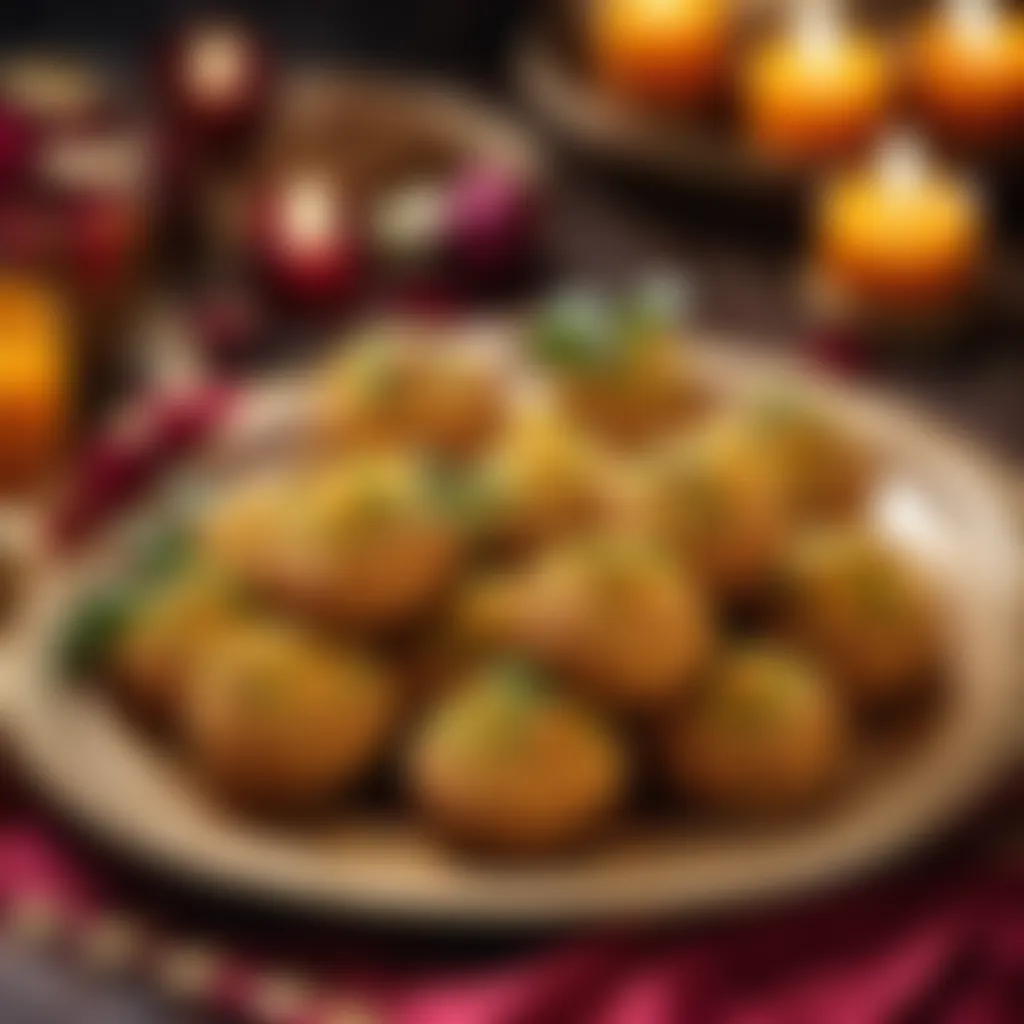

Accommodating Dietary Restrictions
Dietary restrictions can vary widely among households. As Ghewar is traditionally made with specific ingredients, those with dietary concerns need to pay special attention when crafting this dessert. Here are several considerations:
- Gluten Sensitivity: For individuals with gluten intolerance or celiac disease, alternative flours can be employed to create a gluten-free version. One might consider using besan (gram flour) or even almond flour mixed with a binding agent.
- Vegetarian/Vegan Needs: Ghewar can be made vegetarian-friendly easily since it primarily uses plant-based ingredients; however, for vegans, substitutes for ghee can include coconut oil or plant-based butters.
- Sugar Alternatives: The sweet flavor of Ghewar usually comes from a sugar syrup. For those managing their sugar intake, using natural sweeteners like jaggery or stevia might be a route to explore.
- Low-Fat Versions: Those aiming to cut down on fats can reduce the amount of ghee used in the batter without sacrificing too much flavor, although the unique texture might alter slightly.
Being aware of these dietary modifications not only makes Ghewar more inclusive but also allows every guest at your table to indulge in this traditionally cherished dessert without worry. It’s about balancing the essence of Ghewar with the needs of those who enjoy it, ensuring that the joy of sharing and celebrating remains at the forefront.
The Role of Ghewar in Festivals
Ghewar, with its distinctive honeycomb structure and delectable sweetness, is more than just a dessert in India; it's a symbol of celebration, especially during festivals. The presence of Ghewar at festive gatherings reflects its deep roots in cultural traditions and highlights its role as an offering of joy and unity.
Teej Festival
During the Teej festival, which marks the onset of the monsoon season, Ghewar takes on a special place in the hearts of many. The festival predominantly celebrates the bond between married women and their husbands. Women observe fasting and pray for their husband's longevity and prosperity. Ghewar is prepared in various forms — plain, with rabri, or adorned with nuts. It's a gesture of love and devotion that brings families together.
The origin of this tradition can be traced back to Rajasthan, where elaborate celebrations are held. It's said that the sweet delight not only serves as a treat for the palate but also symbolizes the vibrant hues of the season. The intricate preparations of Ghewar during this time reflect the meticulous nature of Indian cooking and the festive spirit that permeates gatherings.
"Celebrating Teej with Ghewar is like adding a sprinkle of sweetness to the prayers for loved ones."
When preparing Ghewar for Teej, many families pass down techniques from generation to generation, ensuring that each piece captures the essence of tradition. The soft and porous texture of Ghewar makes it an ideal dish to soak in the flavored sugar syrup, elevating its taste and making it a much-anticipated dish during the festivities.
Raksha Bandhan
Similarly, during the festival of Raksha Bandhan, Ghewar holds a place of prominence. This festival celebrates the sibling bond, where sisters tie a protective thread around their brothers' wrists, symbolizing love and duty. In return, brothers promise to take care of their sisters. The exchange of sweets, notably Ghewar, is an integral part of this ritual.
Ghewar comes as an ideal sweet for this occasion because it conveys both love and commitment. Sweets generally symbolize the joy of relationships and the shared memories we've crafted over time. When brothers and sisters share Ghewar, it serves as more than just a delicious treat; it becomes a binding thread that fortifies familial ties.
In both Teej and Raksha Bandhan, the act of preparing and sharing Ghewar involves more than mere culinary skills; it embodies a cultural ethos that fosters unity within families and communities. The aromatic and rich flavors of Ghewar resonate with the festive atmosphere, leaving an indelible impression on everyone who partakes in the celebration.
By understanding the roles Ghewar plays during these significant occasions, one can appreciate how a simple dessert becomes a vehicle of connection and love. It transforms ordinary occasions into cherished moments, steeped in cultural significance, and ensures that generations can continue to share in its delight.
Modern Adaptations
The contemporary culinary landscape has always been influenced by innovation, and Ghewar is no exception. Modern adaptations of this traditional dessert are not just about tweaking recipes; they symbolize a bridge between heritage and contemporary tastes. They allow for creativity while respecting the essence of the dish. This section explores fusion recipes and commercial production techniques that breathe new life into Ghewar, making it accessible to a broader audience.
Fusion Recipes
With the world becoming increasingly interconnected, it's no surprise that culinary fusions are gaining momentum. The idea of amalgamating Ghewar with diverse flavors or ingredients opens a treasure trove of possibilities. Consider, for instance, the incorporation of matcha powder into the batter. This brings an earthy note alongside the classic sweetness, appealing to those with a more adventurous palate.
Another intriguing combination is the saffron-infused Ghewar with a hint of cardamom—ideal as a sophisticated dessert to serve at dinner parties. You might even experiment with a chocolate Ghewar, drizzling melted chocolate over the delicate layers, transforming it into a modern treat that still pays homage to its roots.
- Variations to Consider:
- Matcha Ghewar: Unique, vibrant color and flavor.
- Chocolate Ghewar: Perfect for chocolate lovers.
- Tropical Ghewar: Adding mango or coconut for a summery twist.
These fusion recipes spotlight the versatility of Ghewar, allowing the dessert not just to fit every occasion but to astonish the palate with novelty.
Commercial Production Techniques
The demand for traditional sweets like Ghewar is rising, leading to innovative commercial production techniques. These methods prioritize efficiency while maintaining the flavor and essence of the original recipe. In commercial kitchens, the batter is often prepared using high-speed mixers, ensuring a consistent texture that might be hard to replicate at home.
Moreover, many producers are now using automated frying techniques with temperature control systems. This precise temperature regulation prevents issues like browning too quickly or frying unevenly. It might lack that home-cooked charm, but it does lead to a more uniform product that can meet consumer demands.
Here's a glimpse of the elements involved in commercial Ghewar production:
- Batch Processing: Ensures consistency in taste and texture.
- Enhanced Frying Equipment: Automates and optimizes frying processes.
- Quality Control: Regular checks to maintain product standards.
"Commercial production may not always capture that home-made essence, but it indeed paves the way for accessibility and regular availability of beloved sweets like Ghewar."
These advancements allow more individuals to savor Ghewar, regardless of geographical constraints.
Finale
When it comes to Ghewar, this isn't merely a sweet treat; it's a tapestry woven with history, culture, and culinary finesse. The act of preparing Ghewar is as significant as savoring its unique flavors. This article has taken you through the countless facets of Ghewar—from understanding its essential ingredients to appreciating the regional variations that come into play during festive seasons.
Reflecting on the Tradition
At its core, Ghewar represents the culinary heritage of India, particularly in Rajasthan. Its delicate structure and sweetness are not just about taste; they resonate with the traditions passed down through generations. For instance, many families have their own beloved recipes for Ghewar, often honed over years of practice, which adds a Personal touch and deep-rooted connection to the dish. Each time one makes Ghewar, it is a nod to the past, an homage to the artisans who mastered it. This bond with tradition not only keeps the culinary practice alive but also strengthens family ties, as preparations become communal gatherings filled with stories & laughter.
Encouraging Culinary Exploration
Diving into the world of Ghewar extends beyond the mere creation of a dessert. It invites novice cooks and seasoned chefs alike to push boundaries. Why not try experimenting with different flavors? A saffron-infused Ghewar or perhaps a fusion version with chocolate could surprise your taste buds! Learning about Ghewar encourages homemade culinary adventures while unearthing a wealth of forgotten recipes and techniques.
Furthermore, don't shy away from sharing your experiences. Whether posting on Reddit or discussing on Facebook groups, you contribute to a growing body of knowledge that celebrates traditional Indian cuisine. The more you explore, the deeper your understanding will be—not just of Ghewar, but of Indian culture as a whole.
"Cooking is like love. It should be entered into with abandon or not at all."
In summary, Ghewar is more than a dessert; it’s a significant part of Indian culture, one that deserves to be cherished and shared. So roll up your sleeves, gather your ingredients and create some sweet memories.







